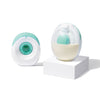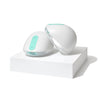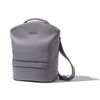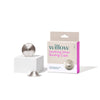If you plan to breastfeed when you return to the office, you’ll need to make the transition from exclusively nursing to pumping for part of the day. Breast pumping isn’t without its challenges, but it’s easier than ever thanks to innovative new products and more legal protections in the workplace. We asked the experts at Willow to answer some of the most common questions about breast-pumping at work. Here, is Willow’s best advice for the most common pumping conundrums.
When should I begin breast-pumping?
We recommend starting a pumping routine at least two weeks before you head back to the office. Think slow, sure and stress-free. Start with 7 to 14 pumping sessions per week, so you can begin building a small stash, get comfortable with your pump and build your confidence for your return to work. You’ll want to have enough frozen breast milk ready to feed your baby on your first day back. Babies under six months old will usually need about one ounce per hour when you are apart, while babies over 6 months old may need a bit more. (If they have taken really well to solids, one ounce per hour will work as well.)
How should I store my pumped breast milk?
You can store breast milk in the freezer for up to 6 months in a clean, capped food-grade glass container or hard plastic container that's not made with the chemical bisphenol A (BPA). You can also use special plastic bags designed for milk collection and storage, like Willow’s. Write the date you expressed the milk on the container in permanent ink, along with your baby’s name if your little one goes to a child care center. Freshly expressed breast milk can be stored in the back of the refrigerator for up to four days, but it’s best to use or freeze the milk within three days.
Portable Breastmilk Milk Cooler
Portable Breastmilk Milk Cooler
Store up to 16 oz of milk at a safe temperature for up to 24 hours with our new patent-pending Portable Breastmilk Cooler. It's the breastmilk chiller you'll bring everywhere.
How often should I pump at work?
You’ll want to pump as often and for as long as your baby would normally nurse. Generally, it’s a good rule of thumb to pump every 3-4 hours for about 15-20 minutes a time. But every woman is different, and some may need more or less time depending on how much milk they produce.
Where should I pump at work?
Most employers are required by federal law to provide you a place to pump that isn’t a bathroom, has a door that closes and is “free from intrusion from coworkers and the public.” You’re also entitled to breaks for pumping, too. Some states have laws requiring additional accommodations. To see the laws in your state, and get guidance on how to talk to your boss about your breast-pumping needs, check out this handy guide by legal advocacy organization A Better Balance.
The good news is many companies have added comfy lactation rooms for their breast-pumping employees. The best ones come with a comfortable chair, outlets for an electric pump, a refrigerator for storing breast-milk, a sink for easy clean-up, a locked door, and an online system for reserving the room.
How should I prepare for my first week back at work?
First, make sure you have your pump and all its parts (including storage bags, if needed), a comfy nursing bra, and an insulated storage bag for bringing your milk home. Then, get your game plan ready: Let's say that you will be separated from your baby for 10 hours on your first Monday back at work. Your pumping goal for the two weeks prior to returning will be to pump 10 ounces so you are covered for Monday.
-
Sunday evening: Defrost 10 ounces and prepare several bottles.
-
Monday: Pump at work when you would normally breastfeed (ideally every three hours). Monday's pumped milk will feed your baby on Tuesday, Tuesday's will feed your baby on Wednesday, and so on.
-
Friday: Freeze the milk pumped that day, breastfeed all weekend and defrost your oldest milk on Sunday night for Monday. This schedule provides your baby with fresh milk every day except Monday.
What kind of pump should I use?
A double electric breast-pump is the best bet so you can easily pump on both sides at the same time. Be sure to think about how you plan to store and transfer your pumped milk. Some systems require pumping into a bottle, then transfering into a storage bag, which can be an onerous process. Wearable systems like Willow make taking milk home much easier, since milk can be pumped directly into storage bags. Wearable systems offer some other prime perks, too: They’re quiet and discreet. They’re easy to clean, too, because they typically have fewer parts. (The Willow has a flange and a tube that connects to the pump, and that’s it.)
The Affordable Care Act requires that all private health insurers cover breast pumps. Call your insurer to find out which models are included in your coverage. If a pump you like isn’t fully covered, it’s often possible to get a partial reimbursement. You can also use money in an FSA/HSA to pay for a breast-pump.
Willow 360™ Wearable Breast Pump
Willow 360™ Wearable Breast Pump
Willow 360 is designed with a zero-gravity latch to give you 360° of leak-proof mobility. It's the hands-free breast pump that changed the game.
Willow Go™ Wearable Breast Pump
Willow Go™ Wearable Breast Pump
With hospital-grade suction and a 100% comfort rating, Willow Go pumps quietly and discreetly (no dangling tubes, bottles, or external motors) so you can do it all.
What should I do if I’m not producing enough milk?
It’s totally normal to experience a drop in your milk supply, which can be caused by everything from hormonal changes to stress. The most common problem is not pumping or feeding enough. Since milk is produced on a supply and demand basis, not pumping on a frequent schedule will signal to your body that it does not need to produce milk. Try adding more pumping sessions and making them longer. Make sure your pump flange size is correct, and that you have an efficient breast pump. Foods like fenugreek, oatmeal, lean meat, and leafy greens contain various chemical properties that can potentially help increase your milk supply. (There are even yummy lactation treats on the market chock full of these ingredients.) If you can, take a “nursing vacation.” Schedule up to 3 days where you simply nurse as much as possible with your baby. During that time be sure to rest, eat a well-balanced diet, and stay hydrated. If all else fails, don’t feel guilty. Many a mom has supplemented with formula and raised a happy, healthy baby—and you will too.
Get dressed with Armoire
Get dressed with Armoire
Find breastfeeding-friendly clothes that fit and give you confidence with a subscription to Armoire. Each delivery comes with 4, 6, or 7 pieces. Use code WILLOW for up to 50% off your first month.





















